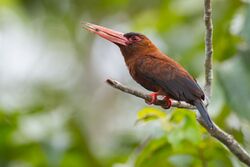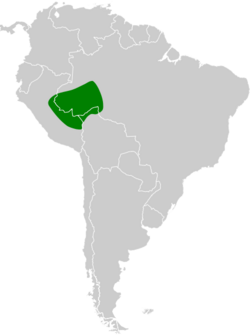Biology:Purus jacamar
| Purus jacamar | |
|---|---|

| |
| Scientific classification | |
| Domain: | Eukaryota |
| Kingdom: | Animalia |
| Phylum: | Chordata |
| Class: | Aves |
| Order: | Piciformes |
| Family: | Galbulidae |
| Genus: | Galbalcyrhynchus |
| Species: | G. purusianus
|
| Binomial name | |
| Galbalcyrhynchus purusianus Goeldi, 1904
| |

| |
The Purus jacamar (Galbalcyrhynchus purusianus) is a species of bird in the family Galbulidae. It is found in Bolivia, Brazil , and Peru.[2][3]
Taxonomy and systematics
The Purus jacamar shares genus Galbalcyrhynchus with the white-eared jacamar (G. leucotis). They were originally treated a separate species, then as conspecific ("chestnut jacamar"), but are now understood to be separate species.[4] The Purus jacamar is monotypic.[2]
Description
The Purus jacamar is 20 cm (7.9 in) long and weighs 50 g (1.8 oz). It is stouter than many jacamars, and has a more robust bill. It is almost entirely chestnut, with dark bronzy forehead, crown, wings, and tail. The juvenile is paler and its bill is shorter.[3]
Distribution and habitat
The Purus jacamar is found in the upper Amazon Basin of eastern Peru, western Brazil, and northern Bolivia. In this humid region, it inhabits terra firme and várzea forest, both primary and secondary. It prefers edges such as along waterways and oxbow lakes.[3]
Behavior
Feeding
The Purus jacamar preys on insects, with Hymenoptera (bees and wasps) and Isoptera (termites) favored. It perches at mid- to upper canopy height singly or in small groups and sallies out to capture its prey.[3]
Breeding
The Purus jacamar has been documented excavating cavities in termite nests high in trees in Brazil and Peru. It is apparently a cooperative breeder, as the Peru cavity was excavated by six individuals and groups of up to six individuals have been noted singing together.[3]
Vocalization
The Purus jacamar's vocalizations are essentially identical to those of white-eared jacamar. The song is a rising trill [1] and the calls "a series of loud 'peeeur' whistles and a sharp 'pee'” [2].[3]
Status
The IUCN has assessed the Purus jacamar as being of Least Concern.[1] It ranges from scarce in Peru to locally common in Brazil and "[a]pparently tolerates disturbed and partially man-modified habitats, and no specific threats are known."[3]
References
- ↑ 1.0 1.1 BirdLife International (2018). "Galbalcyrhynchus purusianus". IUCN Red List of Threatened Species 2018: e.T22682170A130076817. doi:10.2305/IUCN.UK.2018-2.RLTS.T22682170A130076817.en. https://www.iucnredlist.org/species/22682170/130076817. Retrieved October 7, 2023.
- ↑ 2.0 2.1 Gill, F.; Donsker, D.; Rasmussen, P. (January 2021). "IOC World Bird List (v 11.1)". https://www.worldbirdnames.org/.
- ↑ 3.0 3.1 3.2 3.3 3.4 3.5 3.6 Tobias, J., T. Züchner, T.A. de Melo Júnior, and G. M. Kirwan (2020). Purus Jacamar (Galbalcyrhynchus purusianus), version 1.0. In Birds of the World (J. del Hoyo, A. Elliott, J. Sargatal, D. A. Christie, and E. de Juana, Editors). Cornell Lab of Ornithology, Ithaca, NY, USA. https://doi.org/10.2173/bow.purjac2.01 retrieved May 9, 2021
- ↑ Remsen, J. V., Jr., J. I. Areta, E. Bonaccorso, S. Claramunt, A. Jaramillo, D. F. Lane, J. F. Pacheco, M. B. Robbins, F. G. Stiles, and K. J. Zimmer. Version 19 January 2021. A classification of the bird species of South America. American Ornithological Society. https://www.museum.lsu.edu/~Remsen/SACCBaseline.htm retrieved January 19, 2021
Wikidata ☰ Q1265756 entry
 |


